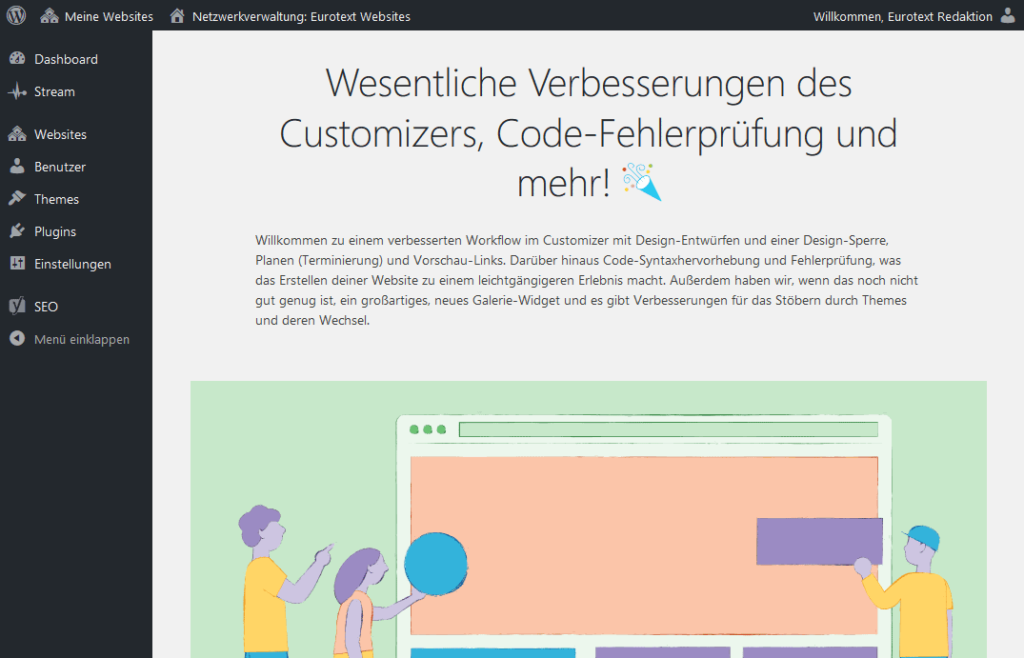The technical implementation of internationalization in e-commerce: what is the best way to go about it? In the second part of our article on the versatile content management system WordPress, we concentrate on e-commerce and the implementation of comprehensive, professional translations in WordPress. We also answer the question of how suitable WordPress is for multilingual e-commerce projects.
WooCommerce & co. – The modular online shop
Let us now take a look at our actual topic, e-commerce. There are many ways to use WordPress for the purposes of e-commerce, the most successful by far being WooCommerce:
 Alex Frison: WooCommerce is a plugin based on WordPress. Installation is really simple and the functions are extensive, even in the basic version. WooCommerce is developing at a rapid rate, with a new version coming our every 3-6 months. As already mentioned, the market share now amounts to just over 40% worldwide. Adaptations are still necessary to ensure that, from a technical point of view at least, the online shop meets all of the legal requirements of the German market. Two easy-to-install and easy-to-customize plugins address this issue: WooCommerce German Market (paid) and Germanized (free basic version).
Alex Frison: WooCommerce is a plugin based on WordPress. Installation is really simple and the functions are extensive, even in the basic version. WooCommerce is developing at a rapid rate, with a new version coming our every 3-6 months. As already mentioned, the market share now amounts to just over 40% worldwide. Adaptations are still necessary to ensure that, from a technical point of view at least, the online shop meets all of the legal requirements of the German market. Two easy-to-install and easy-to-customize plugins address this issue: WooCommerce German Market (paid) and Germanized (free basic version).
But can a CMS with just a few plugins really keep pace with dedicated shop solutions?
Alex Frison: Yes. We have now implemented a number of large shops with very large order volumes and connections to third-party systems, such as SAP. The major advantage of WordPress is its expandability. There are no limits to its functionality, with many functions coming in the form of simple plugins (the community is very large). Functions that aren’t available as plugins can be developed. That’s what we’re here for! Other shop systems may have more out-of-the-box functions, but the implementation of additional functions isn’t always possible, can be overly complicated, and some of the functions simply don’t exist yet.
 The question we are really trying to answer is: How well prepared are the various shop systems for internationalization? We know that WordPress can be made multilingual with the right plugins. We also know that it can be used to operate a serious online shop. But can it do both? The answer is: yes and no. Because just as with the media management issue, there is the problem that each language version represents its own site and these sites have to be coordinated with one another. The German shop isn’t aware of customers placing orders in the English shop. And if a certain product is sold in the German shop, the English shop isn’t aware of this and will show the product as fully stocked. When it comes to media management, this disadvantage may be offset by several advantages, but the issue is a lot more complicated for stock keeping, customer management and order management. As a result, a multilingual shop based on WordPress almost inevitably needs a system in the background that takes care of these tasks centrally.
The question we are really trying to answer is: How well prepared are the various shop systems for internationalization? We know that WordPress can be made multilingual with the right plugins. We also know that it can be used to operate a serious online shop. But can it do both? The answer is: yes and no. Because just as with the media management issue, there is the problem that each language version represents its own site and these sites have to be coordinated with one another. The German shop isn’t aware of customers placing orders in the English shop. And if a certain product is sold in the German shop, the English shop isn’t aware of this and will show the product as fully stocked. When it comes to media management, this disadvantage may be offset by several advantages, but the issue is a lot more complicated for stock keeping, customer management and order management. As a result, a multilingual shop based on WordPress almost inevitably needs a system in the background that takes care of these tasks centrally.
Alex Frison: With our large Woocommerce projects, a merchandise management system is usually connected in the background. Stock keeping, customer management and order management are handled centrally in one place, no matter how many sites are present in the multisite. However, many users do not need a central reference point, as they have separate stock for each country, no stock at all or digital goods only. The same applies to the customer base, which is sometimes separated deliberately. We often see cases where this separation is seen as desirable rather than a disadvantage.
 Our partner Alex Frison has been working with WordPress for over 10 years, is co-owner of Inpsyde and implements WordPress-based projects for medium-sized and large companies, with e-commerce often a focal point.
Our partner Alex Frison has been working with WordPress for over 10 years, is co-owner of Inpsyde and implements WordPress-based projects for medium-sized and large companies, with e-commerce often a focal point.Very flexible and highly customizable
Let’s summarize: In order to construct a multilingual online shop, WordPress requires not only the basic installation, but also a plugin that adds multilingualism, one that provides the shop functionality, and possibly a merchandise management system in the background to manage central tasks. Critics will argue that this sounds like anything but a perfect technical basis for an online shop.
Alex Frison: The target group is very diverse; from small shops with home-made pieces to companies with turnover in the millions, who want to design a very individual shop.
Starting translations in and out of WordPress
![]() With WordPress, the subject of translation has to be dealt with on a very individual basis. WordPress itself has been translated into almost all languages, and language files are available for most plugins and themes. Those not available can be translated using free tools like Poedit, or plugins like Loco Translate to edit texts directly in the backend. The CMS texts in WordPress can be edited and of course translated in the backend. When it comes to texts that are to be given to a translation service provider, there are various options available. The classic copy & paste method is only suitable for small amounts of text. A direct export makes more sense when there is a lot of content involved, because it reduces not only the workload but also the potential for errors. Inpsyde has developed the translationMANAGER for WordPress plugin for this purpose. It allows the user to select and export sites, posts and custom post types, and then reimport them after translation.
With WordPress, the subject of translation has to be dealt with on a very individual basis. WordPress itself has been translated into almost all languages, and language files are available for most plugins and themes. Those not available can be translated using free tools like Poedit, or plugins like Loco Translate to edit texts directly in the backend. The CMS texts in WordPress can be edited and of course translated in the backend. When it comes to texts that are to be given to a translation service provider, there are various options available. The classic copy & paste method is only suitable for small amounts of text. A direct export makes more sense when there is a lot of content involved, because it reduces not only the workload but also the potential for errors. Inpsyde has developed the translationMANAGER for WordPress plugin for this purpose. It allows the user to select and export sites, posts and custom post types, and then reimport them after translation.
Alex Frison: The translationMANAGER is a direct link to Eurotext that saves the user the effort of having to manually export and import data. It also means that when content is updated in a language it can be sent straight to Eurotext without the need for a time-consuming revision workflow. All in all, the translationMANAGER saves the user a great deal of time.
Where next for WordPress?
 WordPress is permanently under development and besides the many small bug fixes and improvements to day-to-day operations, big changes are also always on the agenda. Can we expect more emphasis to be placed on multilingualism? Will functions that currently need to be added via plugins be included in the WordPress core in the near future?
WordPress is permanently under development and besides the many small bug fixes and improvements to day-to-day operations, big changes are also always on the agenda. Can we expect more emphasis to be placed on multilingualism? Will functions that currently need to be added via plugins be included in the WordPress core in the near future?
Alex Frison: No, multilingualism does not feature in future plans. A few years ago, a fundamental decision was made: WordPress should remain lean and mean. The call for multilingualism is very loud, but the vast majority of WordPress users do not need multilingualism and there are already plugins for it. So why install a function that the vast majority of users will never use?
Conclusion
Let us try to draw a conclusion: How suitable is WordPress for multilingual websites and shops? What advantages does it offer? What disadvantages are there to be reckoned with?
Alex Frison: The fact that multilingualism is not standard with WordPress could be considered a disadvantage. But as already mentioned, there are solutions that convert WordPress into a fully fledged multilingual website.
Plugin solutions are constantly under development and are becoming simpler and more comprehensive. Apart from the previously mentioned media library issue, I do not see any disadvantages to our solution. MultilingualPress does pose a few disadvantages for e-commerce, but we will be tackling those this year with new developments. There is, for example, the lack of synchronization of stocks and users between languages. However, we usually deal with this by using an ERP or other third-party system. And no article synchronization, which is usually irrelevant for different languages anyway. Aside from that there are only advantages.
We would like to thank Alex Frison from Inpsyde for taking the time to talk to us and for providing us with so many interesting insights.
Last edited: March 9, 2018
 Author: Eurotext Editorial Team
Author: Eurotext Editorial Team
We explain how internationalization works, provide tips for your translation projects and outline some of the technology and processes used. We also report on current e-commerce developments and cover a range of language-related topics.

